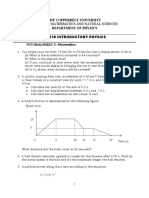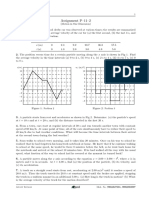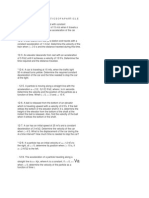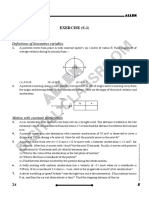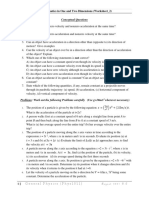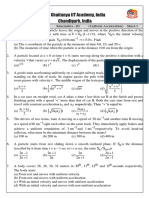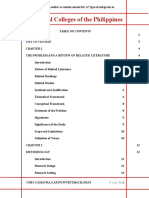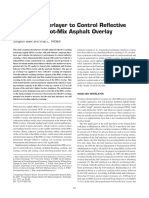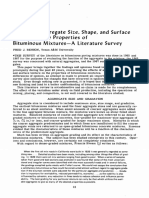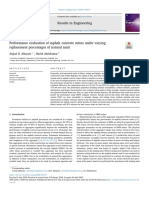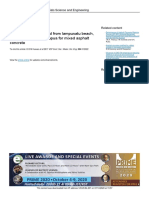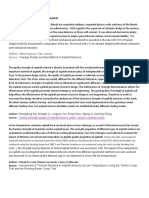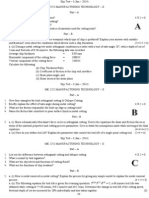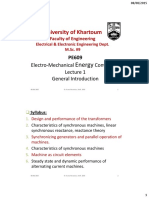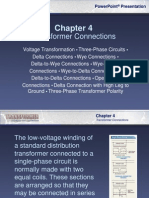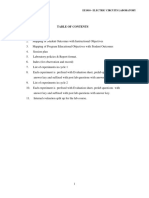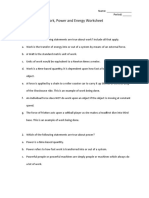CALCULUS-BASED PHYSICS – ENPHYS30
MIDTERM ASSIGNMENT 2 – MOTION ALONG A STRAIGHT LINE
I. Problem Solving.
1. A particle moves such that its displacement (in centimeters) at any time t (in
seconds) measured from a fixed reference point along a straight line, is defined as:
s = 5t 3 + 18t 2 − 8t + 3. How far will the particle travel between the interval
t = 4 sec. and t = 5 sec.?
2. Using the same equation for displacement given in the first problem, what is the
acceleration after 5 seconds?
3. If a particle moves in such a way that its velocity (in meters per second) at any time
t (in seconds) is defined as: v = 6t 2 − 15t + 18, what is the displacement of the
interval from t = 1 sec. to t = 2 sec.?
4. Using the same equation for velocity given in the previous problem, what is the
average velocity and the average acceleration from t = 1 sec. and t = 2sec.?
5. A particle has rectilinear motion such that its velocity is defined as v = −5s 2 ,
where v is in meters per second and s is in meters. What is the position of the
particle at t = 1 second if the particle is 2 meters to the right of the origin at t = 0?
6. A brand new Mercedes Benz is traveling at a highway with a speed of 40 mph and
accelerates to double its speed in just 10 seconds. How far (in meters) did the car
travel during the time it accelerated?
7. A car travels 52 mph for 6 minutes, 46 mph for 3 minutes, 40 mph for 15 minutes
and 44 mph for the remaining time during a 30-minute journey. What is the average
speed of the car?
8. Two cars are traveling from the same place and in the same direction. The first car
started from rest and speeds up with a constant acceleration of 0.3 m/s 2 . The
second car leaves 15 seconds after the first car and speeds up with a constant
acceleration of 0.5 m/s 2 . When will the second car overtake the first car?
9. A car is traveling at 60 kph in a straight road when he noticed that the traffic light
200 meters ahead of him is turning red. The traffic light is programmed to stay red
for 15 seconds and stay green for 30 seconds. If the driver wants to pass the traffic
light without stopping as it will turn green again, what is the velocity of the car as its
passes the light?
Page 1 of 3
� CALCULUS-BASED PHYSICS – ENPHYS30
10. A bicycle, initially with a non-zero velocity, moves in a distance of 100 meters in 10
seconds and 175 meters in the next 13 seconds. What is the velocity at the
beginning of the second interval if the acceleration is constant?
11. A taxicab drives at 50 kph from point A to point B in ‘t’ seconds. The driver applies
brakes for 5 seconds from point B to point C to decelerate the car and give it a
velocity at point C of 32 kph. It will now travel at this constant velocity until point D
for ‘t’ seconds as well. What is the distance from point A to point B if the total
distance from point A to point D is 1 km?
12. In a motorcycle race, world champion Valentino Rossi started to accelerate after he
passed the post marking the start of the track. His acceleration is constant at 10
meters per square second. At time, t = 0, he is 50 meters east of the starting line
and is moving at 20 meters per second. What is his position and velocity after 3
seconds?
13. Two cars travel at the same time from two places (A and B), which are 10 km apart.
It takes the first car 20 minutes to travel from A to B while it takes the other car 16
minutes to travel from B to A. What is the time needed by the cars to meet each
other if they travel at their respective uniform velocities?
14. What is the speed of a soccer ball after is has fell by 300 feet from a certain height?
Assume that it started from rest.
15. How long does it take for a ball tossed up along the y-axis to reach its maximum
height if it was given a vertical initial speed of 15 m/s?
16. A rock is dropped into an old well. After 4 seconds, the sound of the rock splashing
into the water is heard. What is the depth of the well if the speed of sound is 330
meters per second?
17. A boy throws a ball vertically upward with an initial velocity of 3 m/s from the roof
deck of a building. The ball strikes the sidewalk at the ground level after 4 seconds.
What is the velocity with which the ball strikes the ground?
18. A rigid body is dropped from rest at a certain height. In just 1 second, it passes two
points that are 150 feet apart. What is the distance from the higher point where the
body started to fall?
19. An elevator is going up with an initial velocity of 3 m/s and is accelerating constantly
at a rate of 0.5 m/s 2 . At the same instant, a ball is also dropped from a height of
50 meters above the elevator. How many seconds after they started moving will the
ball and the elevator meet?
20. An elevator descends from rest with an acceleration of 5 ft/s 2 until it achieves a
velocity of 15 ft/sec. Determine the time required and the distance traveled.
Page 2 of 3
� CALCULUS-BASED PHYSICS – ENPHYS30
, 21. A particle is moving along a straight line with acceleration a = (12t − 3t1/2 )ft/s2 ,
where ‘t’ is in seconds. Determine the velocity and the position of the particle as a
function of time. When t = 0, v = , and s = 15 ft.
22. A ball is released from the bottom of an elevator which is traveling upward with a
velocity of 6 ft/sec. If the ball strikes the bottom of the elevator shaft in 3 sec,
determine the height of the elevator from the bottom of the shaft at the instant the
ball is released. Also, find the velocity of the ball when it strikes the bottom of the
shaft.
23. A car has an initial speed of 25 m/s and a constant deceleration of 3 m/s 2 .
Determine the velocity of the car when t = 4 sec. What is the displacement of the
car during the 4-s time interval? How much time is needed to stop the car?
24. A sphere is fired downwards into a medium with an initial speed of 27 m/s. If it
experiences a deceleration of a = (−6t) m/s 2, where ‘t’ is in seconds, determine
the distance traveled before it stops.
25. As a train accelerates uniformly it passes successive kilometer marks while
traveling at velocities of 2 m/s and then 10 m/s. Determine the train’s velocity when
it passes the next kilometer mark and the time it takes to travel the 2-km distance.
26. A ball is thrown with an upward velocity of 5 m/s from the top of a 10-m high building.
One second later another ball is thrown vertically from the ground with a velocity of
10 m/s. Determine the height from the ground where the two balls pass each other.
27. A car starts from rest and moves with a constant acceleration of 1.5 m/s 2 until it
achieves a velocity of 25 m/s. It then travels with constant velocity for 60 seconds.
Determine the average speed and the total distance traveled.
28. A particle is moving along a straight line such that its speed is defined as
m
v = (−4s 2 ) , where ‘s’ is in meters. If s = 2m when t = 0, determine the velocity
s
and acceleration as functions of time.
29. A particle starts from rest and travels along a straight line with an acceleration
a = (30 − 0.2v)ft/s 2 , where ‘v’ is in ft/s. Determine the time when the velocity
of the particle is v = 30 ft/s.
30. The acceleration of a particle as it moves along a straight line is given by
a = (2t − 1)m/s 2 , where ‘t’ is in seconds. If s = 1 m and v = 2 m/s when t = 0,
determine the particle’s velocity and position when t = 6s.
Page 3 of 3

